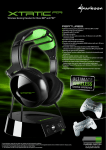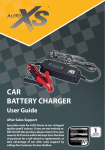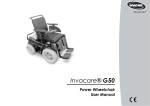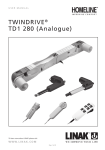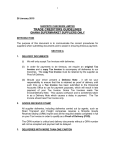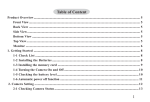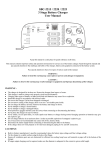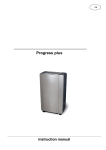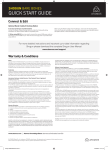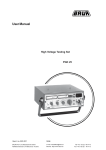Download Batteries and charger
Transcript
B atteries and charger 9.1. Advise on batteries This paragraph contains advice on how to treat the batteries to give them optimum conditions. If something indicates that the batteries are not treated in the right way because of lack of knowledge, these advises can be informed to the user of the chair. How does the charger work? When the battery voltage is low, the charger works extra hard to bring up the battery charge. As the battery voltage approaches full charge, the charger does not work as hard to complete the charging cycle. This explains why the charging current drop as it approaches a full charge. When the battery is fully charged, the amperage from the charger is near zero, thus (when plugged in) the charger maintains but not overcharges the battery. Where Do I Charge The Batteries? Later on in this information, there is reference to the way temperature variations can affect the performance of your vehicle. When charging the batteries, where reasonably practicable, ensure that the battery charger is close to the vehicle being charged so that the temperature of the battery charger and batteries are almost compatible. For example, a vehicle may be outside whilst the battery charger is inside. It is possible in this situation that the battery charger will sense the inside temperature, whereas the batteries on the vehicle will be at the outside temperature, resulting in an overcharged or undercharged situation. How Often Must I Charge The Batteries? Many factors come into play when decided how often to charge the batteries. You may use your vehicle all day on a daily basis or you may not use it for weeks at a time. Other factors such as driver and baggage weight smooth or rough terrain, flat areas or inclines and speed must all be considered. With these variables you should concern yourself with two questions: HOW OFTEN should I charge and for HOW LONG? The charger was designed so there is no way to overcharge your batteries on a regular basis. If you follow the guidelines below, your batteries will provide safe and reliable operation. 1. IF YOU USE YOUR VEHICLE AT ALL WITHIN A DAY: put it on the charger as soon as you have finished using it. The charger is fully automatic so it will not overcharge your batteries. Your vehicle will be ready each morning to give you a full day’s service. It is recommended you charge the batteries for 8-14 hours after daily use. 2. IF YOU USE YOUR VEHICLE INFREQUENTLY (once a week or less): you should charge it at least once per week for 12-14 hours. REMEMBER: keep your batteries fully charged and avoid deeply discharging your batteries. 3. STORING BATTERIES: Batteries should always be stored FULLY CHARGED. Check once a month and recharge fully if needed. Sealed batteries can hold their charge for approx. 6 months. If they are left connected in the chair, remember key switches, meters and accessories can drain the batteries rapidly. It is advisable to disconnect the batteries for prolonged storage. HOW CAN I ENSURE THE MAXIMUM BATTERY LIFE? Simply put, a fully charged battery is a happy battery. A fully charged deep cycle battery will provide reliable performance and extended battery life, so keep your batteries fully charged whenever possible. Please be warned, batteries that are regularly deeply discharged, infrequently charged or stored without a full charge may be permanently damaged providing unreliable operation and limited life. 95 HANDLING BATTERIES Extra care must be taken when handling batteries, if you decide to dismantle the vehicle for transportation etc. Dropped batteries, even from a very small height, can lead to the separators and plates touching, causing a cell failure. Do not leave the charger lead connected to the batteries without the mains supply switched on. In this condition, the batteries will slowly discharge. Used batteries must not be disposed of by means of Domestic Refuse Disposal Unit etc. A recycling station should dispose it, or another place where they can handle used batteries. BATTERY WARRANTIES The batteries fitted to the vehicle are guaranteed against a manufacturing or material defect for 12 months. Any battery faults due to a defect in manufacture or mis-handling will be obvious within a few weeks of use. The batteries are not guaranteed to perform to full capacity for 12 months. This will, of course, be dependent on the actual use of the vehicle and how often the batteries are cycled, i.e. discharged and charged. The gradual deterioration in performance and lack of range is normally associated with fair wear and tear, mis-use or accidental damage. Under these circumstances, the warranty will not apply. WHY DO MY NEW BATTERIES SEEM WEAK Deep cycle batteries employ a much different chemical technology than used in car batteries, nickel-cadmium (Ni-Cads) or other common battery types. They are specifically designed to provide power, discharge down and then accept a relatively quick recharge. We work closely with our battery manufacturer to provide a battery that best suits the vehicle’s specific demands. Fresh batteries arrive regularly and are promptly delivered with a full charge. During delivery they can encounter temperature extremes that may influence their initial performance. Heat will rob the charge from the battery; cold will slow the power available and extend the time needed to recharge (just like a car battery). Simply, a brand-new battery can often act a little stubborn! It might take a few days for the temperature to stabilise and adjust to your room temperature. More important, it will take a few “charging cycles” (a partial drain - then full recharge) to establish the critical chemical balance that is essential to the battery’s peak performance and long life. If you take the time to run-in your battery properly, it will be worth it. REMEMBER: how long your battery will provide service is quite often a reflection of the care it receives. This is how to run-in your new battery:1. Fully recharge any new battery prior to your initial use. This will bring your battery up to about 88% performance. 2. Run your vehicle about the house and garden. Do not stray too far until you become accustomed to the controls, the feel of the vehicle and the break in the batteries. 3. Give the batteries another full charge of 8-14 hours and run the vehicle again. The batteries will now perform over 90% of their potential. 4. After four to five charging cycles the batteries will top of at 100% charge and last for an extended period due to your patience and care in the first few days of operation. 96 HOW CAN I GET MAXIMUM RANGE OR DISTANCE PER CHARGE? Rarely do we have an ideal driving situation such as smooth, flat, hard terrain with no wind or curves. More often, we are presented with hills, path cracks, uneven and loosely packed surfaces, curves and wind. All these will effect the distance or running time per battery charge. Here are a few suggestions for obtaining the maximum range per charge: 1. Always charge your batteries fully prior to your trip. 2. Maintain relevant tyre pressures as stated in the Technical data. 3. Plan your trip in advance to avoid hills, cracks and broken or soft surfaces. 4. Limit your baggage weight to essential items. 5. Try to maintain an even speed to avoid stop and go driving. 6. Ensure recommended routine servicing of the vehicles components, i.e. motors, brakes, electrical connectors etc., is carried out. 97 9.2. ASSESSMENT OF BATTERIES USED IN CYCLIC APPLICATIONS Introduction A great number of rechargeable lead batteries are used in applications where they are routinely discharged and recharged. This type of battery usage is known as cyclic use and is typified by such applications as powered golf trolleys and electrical wheelchairs etc. Where a user perceives a reduced performance from the application then it is necessary to determine the reasons for the reduction and, where this is found to be the battery, to assess feasibility of a possible warranty claim. This document has been prepared to help manufacturers and distributors with the process of assessment of the battery condition. 1. Is the battery defective? Poor performance may be due to the equipment, the battery, the battery charger or abusive use and it is necessary to determine which of these is the cause of the problem. Bear in mind also that a combination of contributory factors may exist. In the absence of special test equipment it may be possible to eliminate some factors by substitution. As an example, a user of an electric golf caddie experiencing poor performance could consider asking another user to test a suspect battery with similar equipment and in this way the caddie itself could be eliminated or confirmed defective. A similar method can be used to check the charging equipment. 2. Physical inspection of batteries A battery being considered for possible reduced performance should be inspected for physical damage, which could lead to rejection of the claim. Points to consider are as follows: a) Damaged Cases - any cracking of the casing, which allows air into the battery, will cause premature failure. Such damage is not always readily obvious with batteries having non-spillable electrolyte and damage could be present on the under surface of cases. b ) Bulging of battery cases - this is usually a sign of overcharging and will be present on all cells. If only one cell is bulged, then this could be a defect. c ) Concave battery cases - this is usually a sign that the battery has been overcharged at a relatively high temperature. On cooling, the valves of the battery will not allow pressure to equalize and “sucking in” of the casing may result. 3. Battery charging A battery, which has been incorrectly charged, will not be considered for warranty purposes and for this reason, the charging regime integrity should be established. The battery requirements in terms of charging voltage and current are specified in the manufacturer’s brochures and the equipment manufacturer will have considered these requirements. It follows that use of other than specified equipment will invalidate warranty claims. Periodic checking of charging equipment by the equipment supplier is recommended. It should be noted that with many chargers, the indication of “charge complete” should not be taken as an instruction to terminate the charging process. In most cases this indication 98 means that the bulk of the charge has been completed but the battery should be left to complete the final few percentage points of recharging. With chargers that feature a “float” charge facility, it is recommended that batteries are left connected to the energized charger until next needed. 4. Guarantee Period The guarantee offered by most battery supplier’s covers failures caused by manufacturing defects within a specified period of time. The terms of guarantee do not cover battery premature failures due to high usage rates or misuse. It is essential to check that the guarantee period has not expired. Sonnenschein batteries are guaranteed for 12 months from date of purchase. 5. Cyclic Life Expectancy of Batteries The number of times that a battery can be charged and discharged before its capacity drops to a specific level is known as its cyclic life. Cyclic life specifications for batteries are quoted for standard laboratory conditions. The actual service life of a battery will depend on many factors such as depth of discharge, temperature, charging conditions etc. Battery warranty claims, which are found to be a result of cyclic life exhaustion, will not be accepted. 6. Cyclic Life Factors The most significant factor affecting cyclic life in service, is the depth of discharge experienced by the battery. The normal limits to battery discharge depth are quoted in the manufacturer’s product brochures. It is important not to exceed these limits if the best cyclic lifetime is to be achieved. To this end it is unwise to allow a battery to continue to discharge when it shows signs of being “flat”. Deep discharge of batteries can result from continuing with a discharge after a period of rest, when the battery has apparently recovered, or using equipment, such as an electric golf trolley, as a “crutch” to assist its user up a slope for instance. In hot temperature conditions, a battery will be capable of providing significantly more duration time than normal. If the battery is allowed to deliver this extra energy, then it will be driven into deep discharge with consequent cyclic life reduction. Batteries are often forced into extremes deep discharge by leaving them connected to electrical consumer circuits when the have been normally discharged. Typically the circuits may be indicators or control circuits taking a very small current of a few milliamps. Under these conditions it is not unusual for a battery to deliver more than 150% of its rated capacity, with consequent deep discharge penalty. Other good examples of over-discharging are trying to achieve too many holes or rounds of golf in a day, or allowing too few hours for recharging between uses. 7. Pre-test checks When assessing batteries returned under guarantee claim by users, the supplier should carry out checks on each battery before conducting performance tests. The physical checks described in 2, should be made and also it should be confirmed that the battery was 99 actually supplied by the organization i.e., proof of purchase should be established. Purchase date should be within the period of guarantee. 8. Voltage tests The open circuit voltage of each battery should be measured using a DC voltmeter of at least 10,000 ohms per volt sensitivity. Batteries having a voltage of less than 1.65 volts per cell (9.9V for a 12V battery) should be rejected as being deeply discharged. Batteries having more than 2.25 volts per cell (13.5V for a 12V battery) may well have been overcharged, particularly if case bulging is also apparent - these batteries should also be rejected. 9. Discharge tests Before carrying out discharge performance tests, the batteries must be fully charged to ensure full charge state. Overnight charging is recommended. The nature of the discharge test will depend on what test equipment is available. Equipment may consist of simple improvised loads such as lamps and resistors or more sophisticated equipment having constant current or constant power discharge capability. By reference to the product brochures it may be ascertained how long a specific battery would support a particular load level until a designated voltage level is reached. The actual achieved test duration time can be divided by the specification duration time to establish the available capacity as a proportion of its specified capacity at the particular discharge rate. It should be noted that the actual capacity achieved on test only be comparable with the nominal battery capacity if the discharge rate is the same as the nominal rate. This means that a battery having a nominal capacity of 25Ah at the C20 rate will only give a comparable test result it discharged for 20 hours. The same battery may well produce over 30Ah if discharged over 100 hours or some 15 Ah if discharged at 1 hour’s rate. This means that the manufacturer’s discharge table must be used for evaluating tests. 10. Interpretation of test results The test results obtained for each battery may be expressed as a percentage of the specified discharge duration. When evaluating the results it is necessary to consider what performance level constitutes an acceptable performance. It is important to differentiate between acceptable performance based on normal battery aging factors and what is expected by the specific users application. To illustrate this point, consider an electric golf cart application, which is particularly demanding. (A very hilly course for instance). It may well be the case that almost 100% of the battery capacity are needed for a typical golf round. As the battery ages, its capacity will gradually reduce and the user may well experience problems when the battery still has 95% of its nominal capacity available. This illustration describes an application where a larger battery would be a better solution. 100 Where test results indicate a battery has marginally unacceptable performance, then it is advisable to fully recharge the battery for a period of at least 48 hours and then repeat the tests. A battery showing an increase in performance of more than 3% on the second test usually indicates that it has been repeatedly undercharged, usually by allowing insufficient recharging time. Such battery claims should be rejected and the user should be advised that more time for each charge should be provided. 11. The Sonnenschein 37531 CFD Battery Capacity Unit and the Astratec Model 39 Test Unit With Cell Fail Detection These testers are simple to use and provide a means of evaluating the performance of 12 volts batteries of 10 Ah size and above. The tester records the discharge time on test for comparison with a supplied battery size table. The unit incorporates a cell failure detector which is set for battery sizes of 20 - 30 Ah and gives an audible warning when they occur early in the discharge process but should be ignored if they occur towards the end of the discharge period. (If a discharge is continued, one cell of the strong six cells must be the first to fail). Note that if the cell fail detector system is used on 16 Ah or 10 Ah batteries an unreliable result may be generated. Conclusion The foregoing should help in the assessment of battery guarantee claims but it is important to bear in mind that it is not just a case of establishing that a battery is defective, but rather to find out why a battery has failed. It is the experience of manufacturers that the majority of claims relate to batteries that have not experienced the correct charging and usage procedures, which are specified in the product brochure. A500 Technical Sheets This sheet gives details of the various numbered sheets and their applicability to different denied warranty claims. Sheet No. 1 - Battery Life Applicable where claim battery shows reduced performance, particularly after 7 - 12 months use. The table gives average use capacities (as opposed to the “one cycle per day” graph). Sheet No. 2 - Undercharging For use where repeat tests show increasing capacity. Customer will need to allow longer periods of time for charging. Sheet No. 3 - Overcharging For use when claim battery exhibit a high terminal voltage without any load connected, or if the battery case is bulged. Customer’s charger should be checked. Sheet No. 4 - Deep discharge For use with claim batteries exhibiting terminal voltage below 1.65 vpc on receipt. The claims should be rejected at this time with details noted such that a repeated claim after recharge is not made. 101 Sheet No. 5 - Exhaustion For use with claims exhibiting low performance with no cell failures after a significant period of use has been achieved (the “warranty nearly expired syndrome”) Sheet No. 6 - Cell Failure Applicable where a cell failure is indicated on test towards the end of discharge and particular near the end of warranty period. A 5oo Technical Sheet No. 1 - Battery Life This sheet gives details of the cyclic life of Sonnenschein “dryfit A500” batteries together with some factors which lead to reduced performance ahead of normal expectation. Cyclic life The “cyclic life” of a battery is the number of times that a battery can be discharged and recharged before its performance falls to a predetermined level. A battery which experiences cyclic usage (golf caddies, electrical wheelchairs etc.) will suffer a small loss of performance each time it is used. Initially, during the “running in” period, the performance will increase but after this a gradual reduction will be observed. It is impossible to give a prediction of the available performance for each individual application because the various factors differ greatly, but the following table illustrates the typical performance available from a battery experiencing average cyclic usage when all recommendations are followed. Performance expressed as a percentage of nominal capacity (Average usage with all recommendations followed) Age (Months) Percentage (%) 1 2 4 6 8 95 100 104 101 98 10 94 12 90 14 84 16 77 18 68 It is not possible to say at what percentage level a battery can be considered since this will vary with application. A hilly golf course, for instance, may need some 90% capacity of a caddy battery to complete 18 holes whilst a more level course may only demand 65%. Factors affecting cyclic life 1. Depth of discharge The number of cycles obtained depends upon how deeply discharged the battery becomes each time it is used. If a battery experience very deep discharge (perhaps by being left connected after use) then it may well only give some 10 - 20 cycles of use. 2. Use in Hot Conditions A battery will give a higher performance when temperatures are high. If this enhanced capacity is in fact used, then deep discharge will result. 102 3. Leaving Battery Discharged If a battery is left in a discharged condition it will rapidly deteriorate - always recharge a battery as soon as possible. 4. Overloading It is possible to overload a battery by using a golf caddy to “help you up a slope” for instance, Such treatment will reduce the battery life 5. Incorrect Charging It is essential that the correct charger is used and that sufficient time is allowed for recharging. Any “charge complete” indications should be treated as “battery usable but leave on charge if not needed” In general, reductions in performance without specific failure indications (such as cell failures on test) are due to the usage of the battery rather than any manufacturing defect. This will be taken into consideration when assessing warranty claims. A 5oo Technical Sheet No. 2 - Undercharging Any lead/acid type battery can suffer reduced performance if it experiences less than ideal charging. The loss of performance can be restored if action is taken quickly, but permanent damage will occur if repeated undercharging is continued. Where batteries have only suffered undercharging for a relatively short period it may be possible to restore a proportion of their performance by discharge followed by an extended period of correct charging. The indications of undercharging are usually an increase in performance on repeated discharge tests. It is important to continue charging, when possible for longer periods and any “charge complete” indications from the charge equipment should be treated as battery usable if needed but continue charging when possible. Undercharging is the most common cause of poor battery performance. A 5oo Technical Sheet No. 3 - Overcharging With conventional flooded plate, vented lead/acid batteries it is possible to accept some degree of overcharging such as high charge voltage setting. This result in excessive gassing from the cells but the situation can be corrected by more frequent topping up with deionized water. With valve regulated type batteries, it is impossible to add water and so the charging regime must be accurately set such that overcharging does not occur beyond the capacity of the recombination valves. Where overcharging has occurred, it is often possible to detect by a high voltage open circuit level on the battery terminals. More significant overcharging may result in swelling of the cell cases, particularly if overheating of the batteries has also been experienced. 103 Batteries that have been overcharging will not be accepted as a valid warranty claim and it is necessary to have the subject charging equipment tested before further use. A 5oo Technical Sheet No. 4 - Deep Discharge A battery, which has been deeply discharged, will normally exhibit a terminal voltage well below the normal (discharge) voltage of some 12 volts with no load connected. Such batteries are normally considered invalid warranty claims since they will have suffered permanent damage and often will not accept a recharge. Deep discharge often results from leaving a battery connected to very small electrical leads such as indicators, monitor circuits or even charging equipment which is not switched on. It is essential to disconnect a battery from all consumer circuits when it becomes discharged and then to recharge the battery at the earliest opportunity. A 5oo Technical Sheet No. 5 - Exhaustion Any lead/acid battery has a service lifetime, which is affected by the way it is used. It is possible to use up the available life of a rechargeable battery in a few months. When a battery is being assessed for possible warranty claim it is important to distinguish between manufacturing defects which are normally covered by warranty and exhaustion of the battery service lifetime which cannot be covered by warranty. A battery which suffers failure due to a manufacturing defect, will normally experience such failure early in the life of the battery and the defect will show up as a cell failure, or in some cases, as a completely open-circuit battery. Failure due to exhaustion normally shows up as a battery, which has a significant reduction of available performance, which has occurred gradually. Although such “aging” is a gradual process it can show up as a sudden failure in some applications. As an example, in golf caddy applications, a battery having a gradual reduction in performance will typically be noticed “suddenly” when the trolley fails to complete 18 holes. Whilst aging of battery is inevitable, there are many factors which can accelerate the process such as: 1. Undercharging - usually by allowing insufficient charging time. 2. Overloading - such as using a golf trolley as a “crutch” to help its user up slopes. 3. Use in hilly areas. 4. Deep discharge - often caused by leaving a battery connected to its equipment after a normal discharge. 5. Failing to recharge at the earliest opportunity. 6. Using unsuitable charging equipment or equipment which is not adjusted correctly. To get the best performance and service lifetime from a battery, it should be remembered that a battery is a consumable item and like any other consumable, the actual service obtained depends on the way in which it is used. 104 A 5oo Technical Sheet No. 6 - Cell Failure A 12-volt lead/acid battery consists of a “chain” of 6,2 volt cells, each of which experiences the same current on both discharge and recharge. This means that the first cell, which runs down - the “weak link in the chain”, will limit discharge. As a battery ages, its performance gradually decreases and a point will be reached where the “weak link” is drawn into the normal discharge period. On test equipment having the required facility, such “weak link” effects will be detected as cell failures towards the end of the discharge. It is important to differentiate between cell failures occurring towards the end of discharge which are essentially a function of normal aging of a battery and those cell failures which occur early in the test which are likely to be caused by defects. A battery showing cell failures towards the end of the discharge test, particularly if the battery has been in use for more than six months will not normally be considered a valid warranty claim. 105 9.3. User manual for GI charger PowerCharge Classic 8A/12A - 24V Battery Charger 1 2 3 4 1 On/off LED indicator. Shows that the charger is connected to 230V. 2 Charging indicator. Shows the charging status. 3 Error indicator. Shows error condition. 4 Battery cable. Cable for connecting battery. 5 Mains cable. Cable for connection to 230V mains. 5 106 AMBIENT ENVIROMENT The charger should be placed on a level surface with the fitted rubber supports turned downward. Keep the charger out of children’s reach. The charger should be positioned so that the leads do not cause an obstruction. If installed near a window, the charger should be protected against direct sunlight as this may contribute to overheating the charger. Keep the charger clean and dust-free. Contact your dealer for instructions on how to clean your charger in cases of severe soiling. The outside of the charger should be cleaned using only a dry cloth. Do not open he charger. Do not place any objects on top of the charger and generally avoid covering the charger in any way. Use the correct supply voltage and frequency. Warning ! Gas: Explosive gasses - avoid flames and sparks. Acid: The acid in the battery is corrosive. If you spill acid, wash and rince abundantly with water. Acid in the eyes can be harmful, rince with water and consult a doctor. Poison: Lead and other chemicals which are used in batteries are poisonous. Wash hands and skin carefully after working with batteries. Only for indoor use. 107 1. Connect the charger to the mains; the on/off indicator comes on. The mains plug works as main switch. It does not matter in which order you connect the mains wire or the charger wire. 2. Check that the battery is of the type stated on the type label on the back of the charger before connecting the charger to the battery. The charger must not be used for nonrechargeable batteries. If the charger is fitted with battery clamps, connect the red clamp to the positive pole and the black clamp to the negative pole. If the charger is fitted with a special connector, this should be connected. The charging indicator flashes. 3. When the battery is about 80% charged, the charging indicator starts flashing faster. When the charging process is completed, the charging indicator remains lit, (with standardprogram only). 4. Disconnect the charger from the battery. The charging indicator goes out. 5. The battery has now been fully charged and the charger is ready for recharging other batteries. WHAT IS WRONG ? On/off Charging indicator *) O N FLASH ES *) O N ON ON O FF ON O FF O FF O FF ON O FF *) PowerCharge Classic 8A 1. Error: Cause: Solution: 2. Error: Cause: Solution: Error indicator ON ON O FF ON O FF FLASH ES Buzzer Error O FF 1 O FF 2 O FF 3 ON 4 O FF 5 O FF 6 The charger is overheated. The ambient temperature is too high or the cooling of the charger is inadequate. Move the charger to a cooler place. The charger is overheated. The ambient temperature is too high or the cooling of the charger is inadequate. Move the charger to a cooler place. 3. Error: Cause: Solution: The battery is not connected. Dirt on battery clamps or terminals or break in battery cables. Check terminals, cables and any fuse in the battery cables. 4. Error: Cause: Solution: Polarisation error. Incorrect polarisation of the battery. Switch the battery clamps. 5. Error: Cause: Solution: The charger is not connected to the mains. Mains power failure. Check the mains cable and the mains socket. 6. Error: Cause: Solution: Battery error. Defective battery. Contact your dealer. In case errors are not remedied by following the above instructions or if it becomes necessary to change the cable, please contact your nearest dealer. May only be repaired by autorized PowerCharge personnel 108 SAFETY FEATURES 1. The output terminals of the charger are protected against short-circuiting. 2. The charger is protected against polarisation errors. 3. The charger is protected against excessive operating temperature. If the cabinet temperature exceeds 45 °C, the charger will automatically lower the current to prevent any further increase in temperature. 4. Provided that the charger is connected to the mains, the design ensures sparkless battery connection. Charging of defective batteries or using a defective battery charger may cause hydrogen to be generated during the charging process. It is therefore recommended that charging is carried out in well-ventilated rooms and operators are warned against the use of open fire in the room during charging. TECHNICAL DATA Mains voltage Effect Nominal charging voltage Charging voltage Charging current Charger capacity Classic 8A AC 230V 50HZ 410 VA 24VDC 8 - 32.5V programmable Max. 8A programmable 20Ah – 80Ah Classic 12A AC 230V 50HZ 450 W, 2,6 A 24VDC 4 - 32.5V programmable Max. 12A programmable 20Ah – 120Ah Dimensions Weight 130*190*60mm + handle 1.7 kg 174*190*81mm + handle 2,25 kg Insulation Class of density Class II, double insulation IPX1, dripproof Class II, double insulation IPX1, dripproof CE-MARK Declaration of responsibility. POWERCHARGE Vestergade 7F DK-7323 Give, Denmark Hereby states that the PowerCharge Classic 8A (GBC02 MKII) and PowerCharge Classic 12A (GBC04) is in agreement with the following standards: EN 12184, EN60335-2-29, EN60601-1, EN60601-1-2 and EN55014 and therefore carries the right to the CE-mark and the name: ”Medical Electrical Equipment”. CERTIFICATE OF GUARANTEE For: POWERCHARGE CLASSIC Battery Charger. Serial Number: Guarantee Period: 27 months from the date of production. The Guarantee covers: Defects in manufacture or materials found in connection with the correct use of the charger. DEALER: 109 9.4. User manual for LADAC charger 10 Directions for use - Ladac 3030BB wheelchair battery charger The charger shall stand on rubber feet or hang on a wall braquet. Connect the charging plug and the mains plug. Order of which is not important. The charger is automatically turned on / off when connected / disconnected to the wheelchair. 1. 2. 3. 4. 5. 6. FLOAT - Green light at float charge. Lits or flashes green - final charge state. Yellow light - 2,5 ampere charging. Yellow light - 5 ampere charging. Red light - 10 ampere charging. ON-lamp - Green light when charging. Fault finding - Mains plug and weelchair connected : No lamp is lit 1.Check mains connection 2.Call for service Attention! D o not cover the charger. The charger may be used for: AGM batteries Gel-batteries Ordinary lead/acid batteries The charger automatically adapts to the current battery type.The charger fits 24VDC batteries, capacity betweeen 24Ah - 90Ah. Environment : When constructing the charger we have concentrated on high efficiency. The charger is recycable. WARNING !! Gassing : Explosive oxyhydrogen gas may be formed in the charging process. It ignites very easily - a small spark is enough. Never smoke or use bare flames etc. close to the batteries. Acid : Battery electrolyte is acidous and corrosive. It attacks human skin , fabrics, metal and paint. If electrolyte is spilled, it should immediately be washed off with plenty of water. If it gets into the eyes, immediately rinse with water and contact a doctor. Poison : Lead and some chemical agents used in batteries are very poisonous. Wash hands and skin thorougly after working with batteries. 110
















